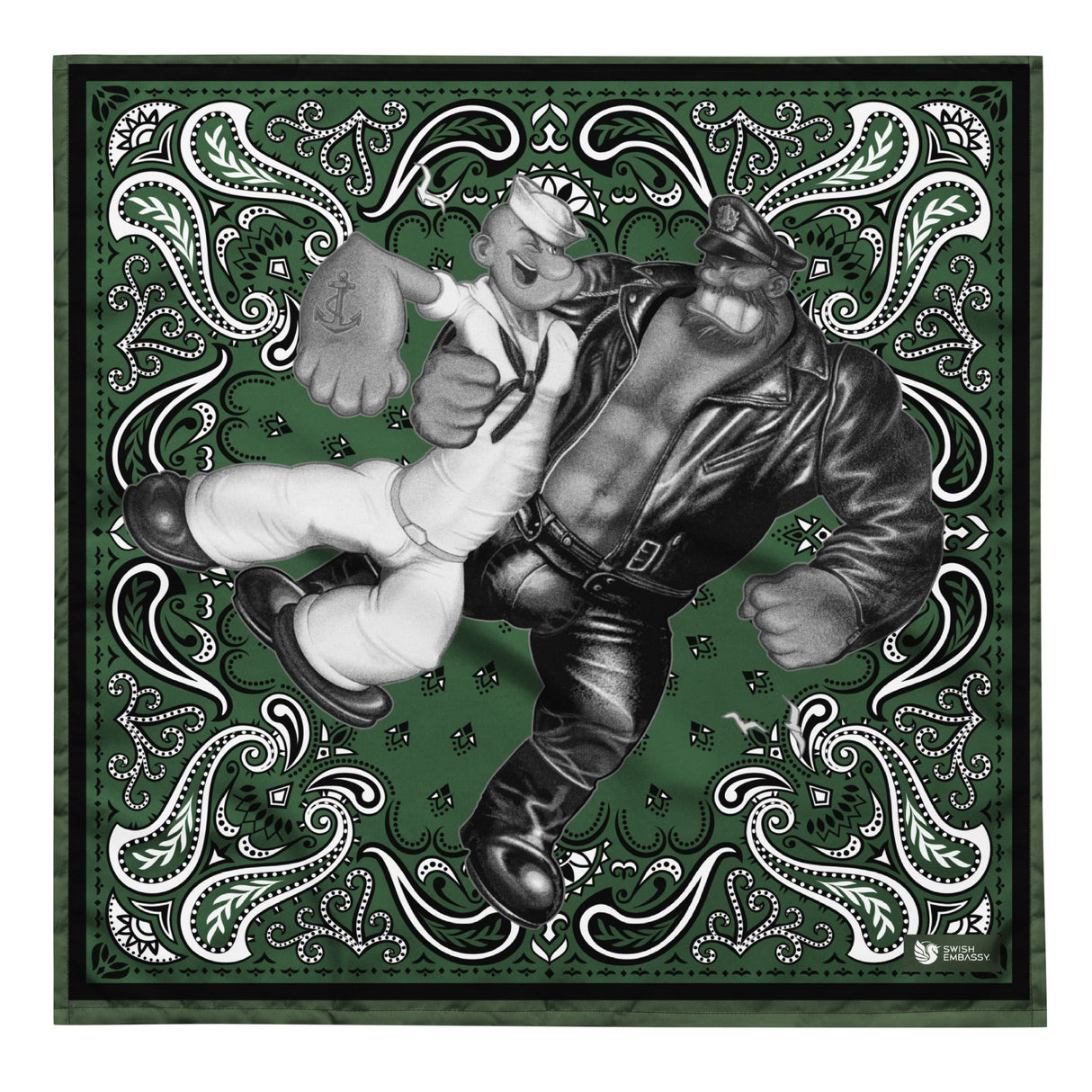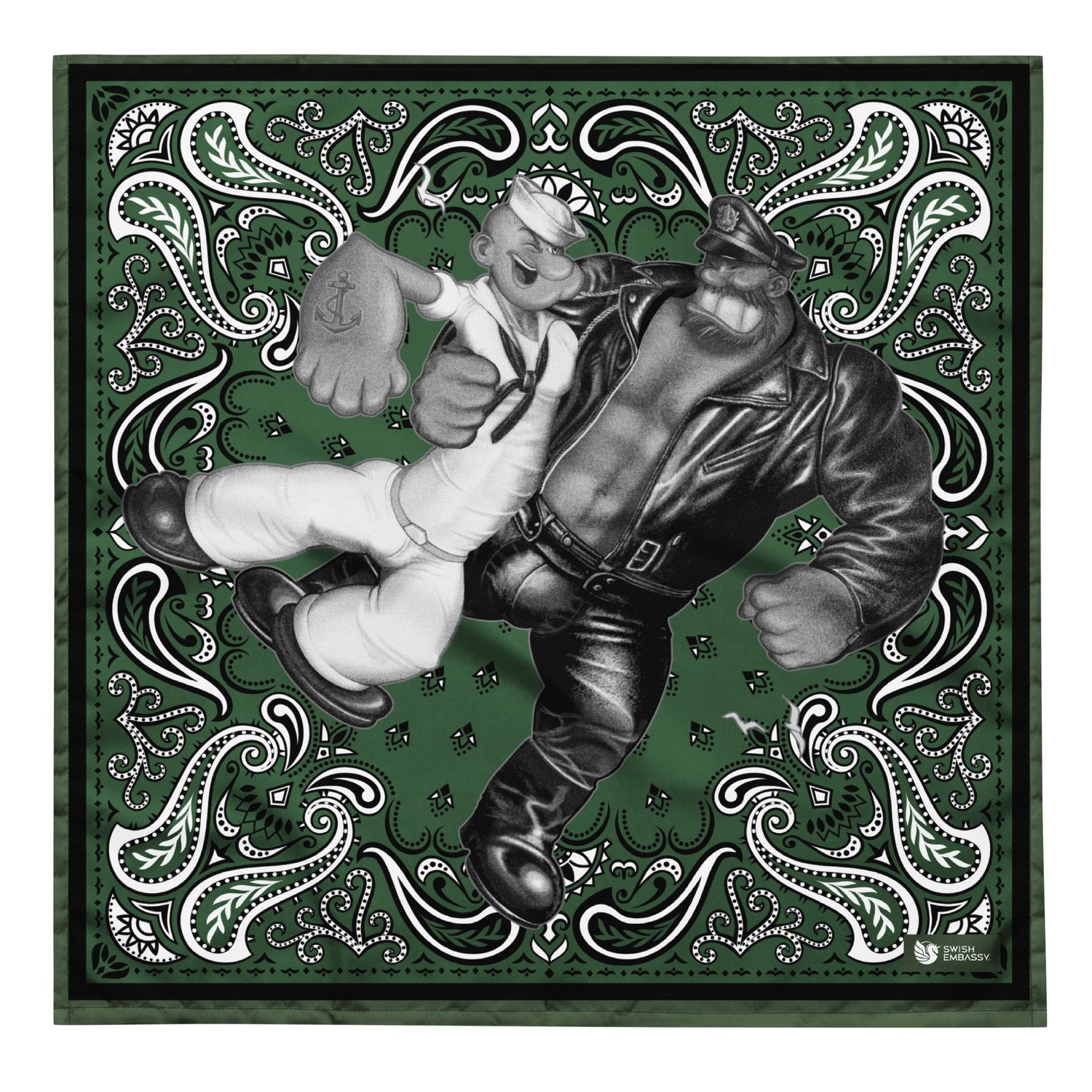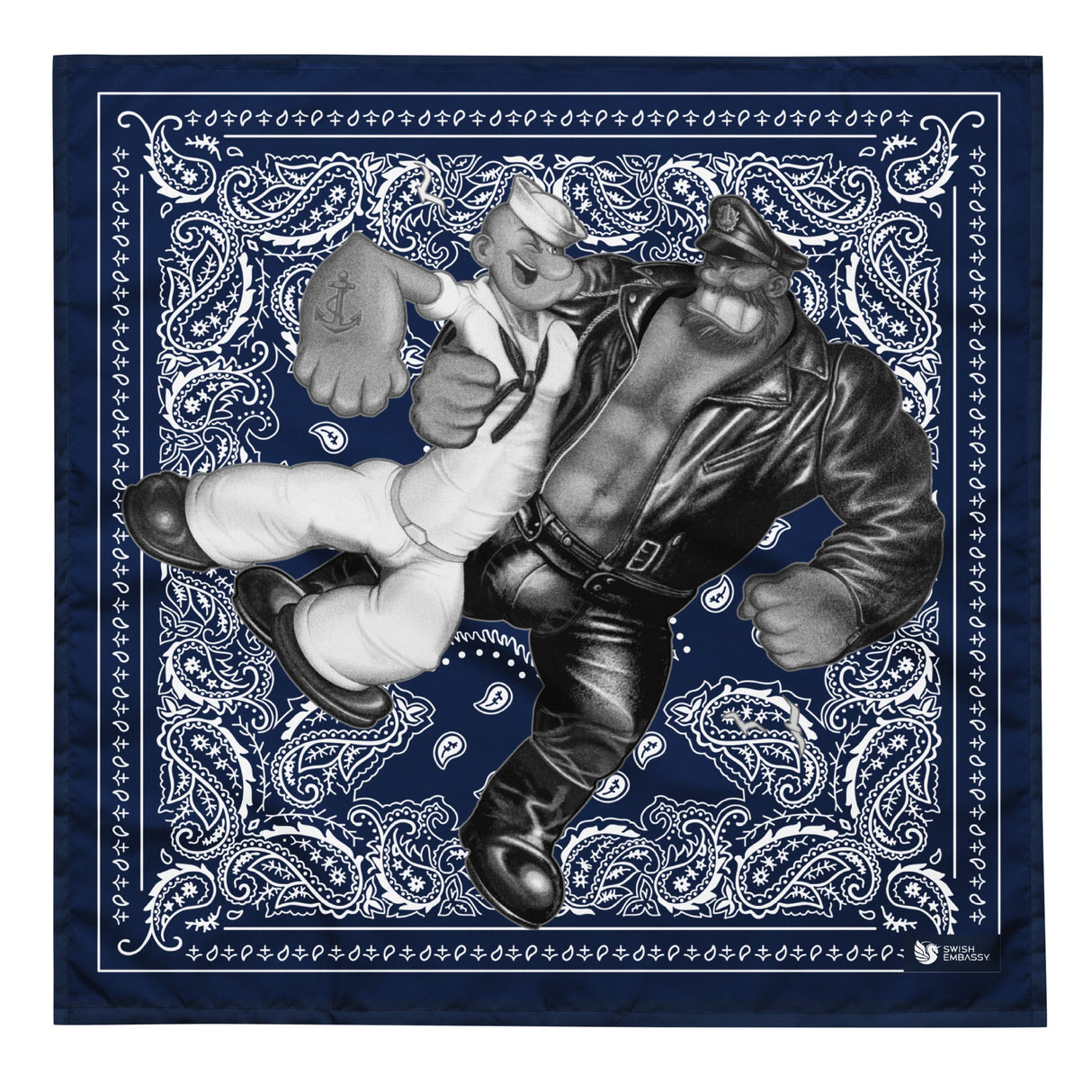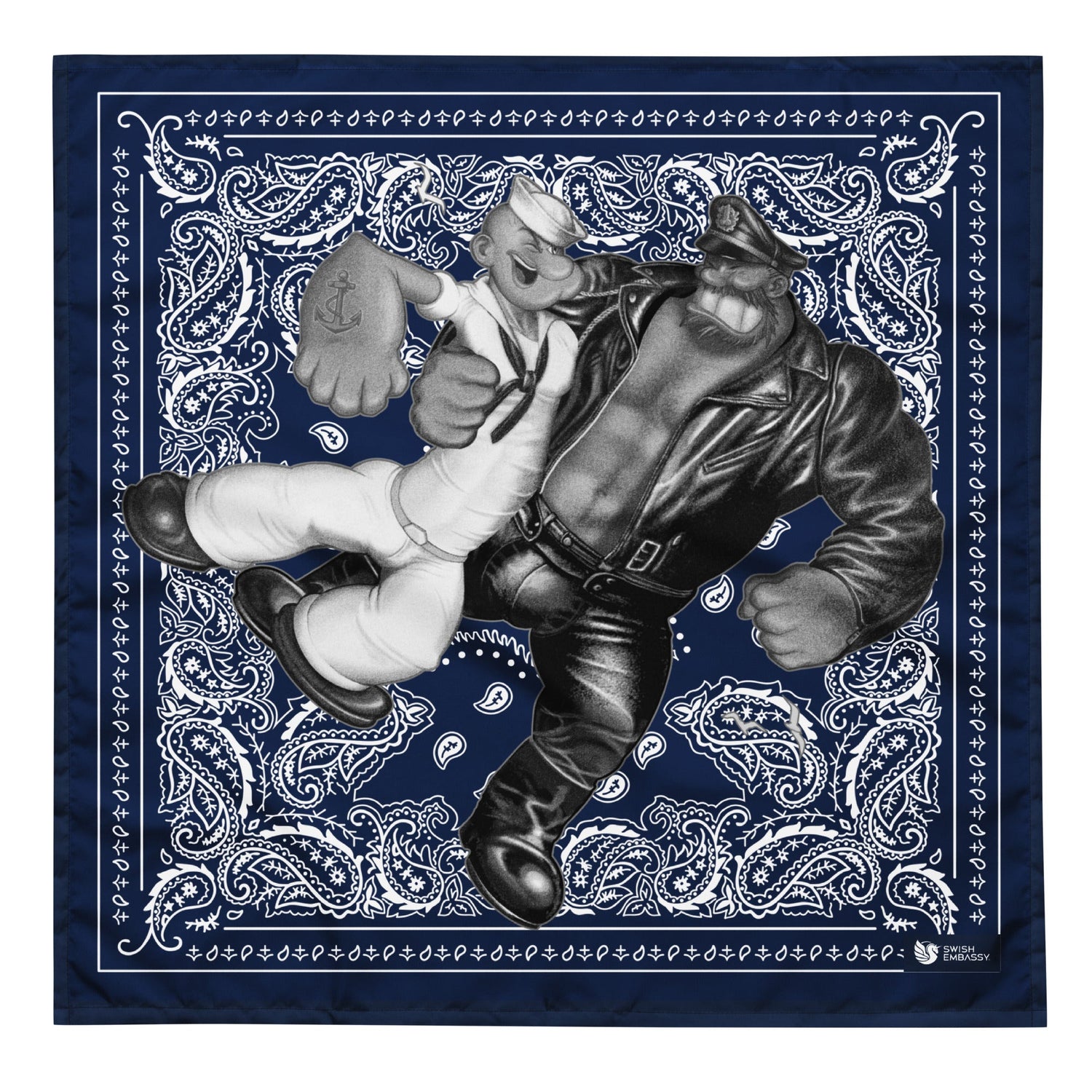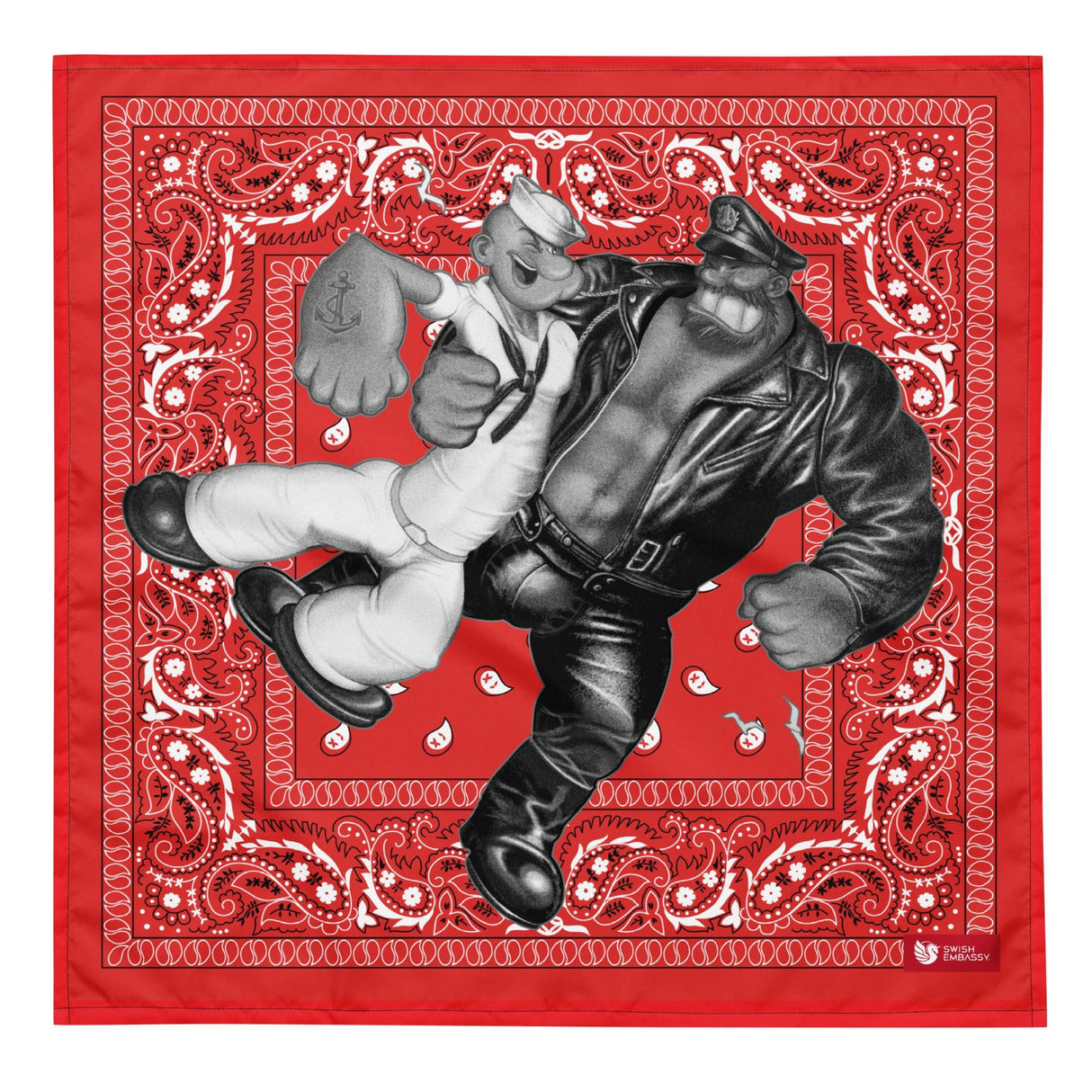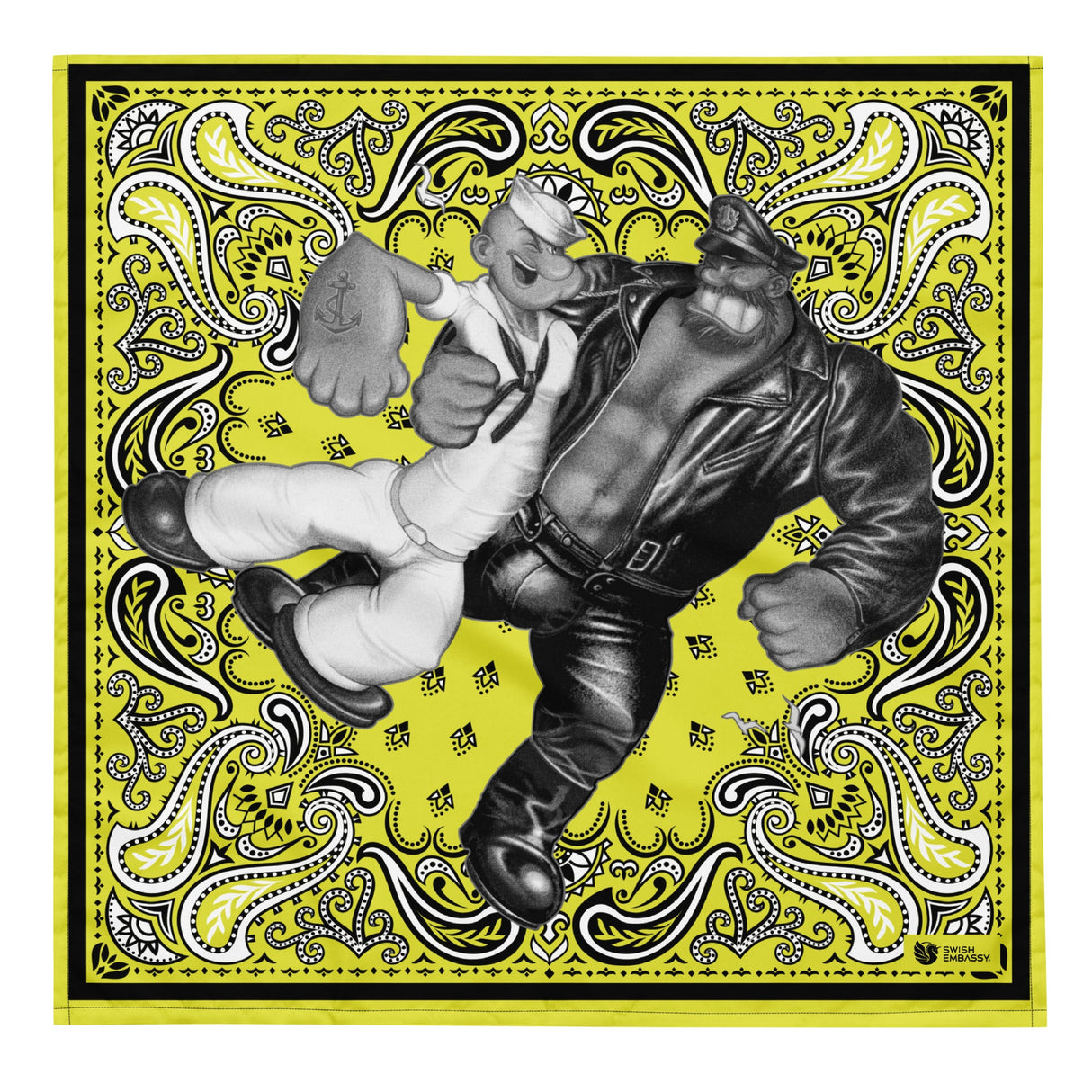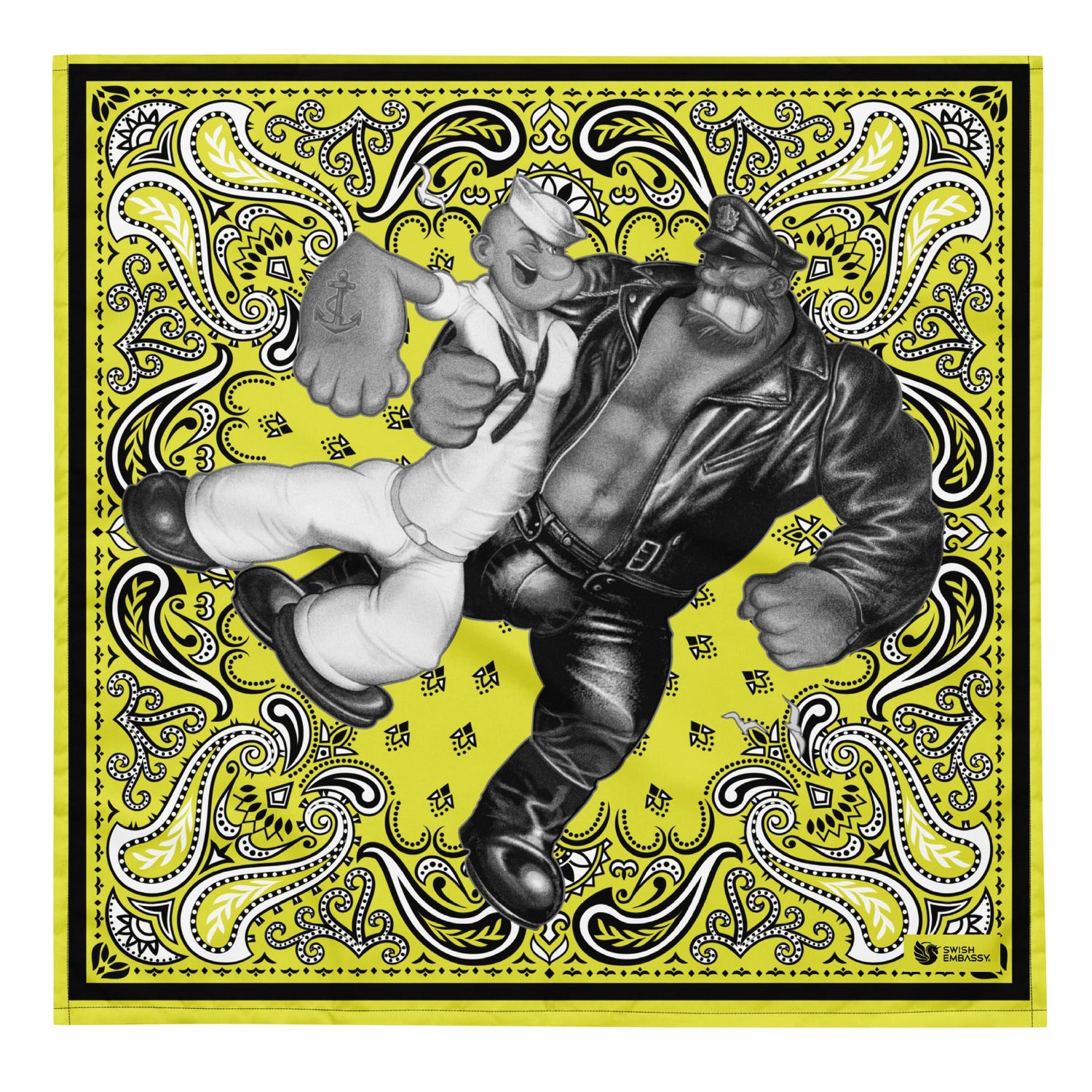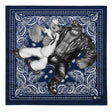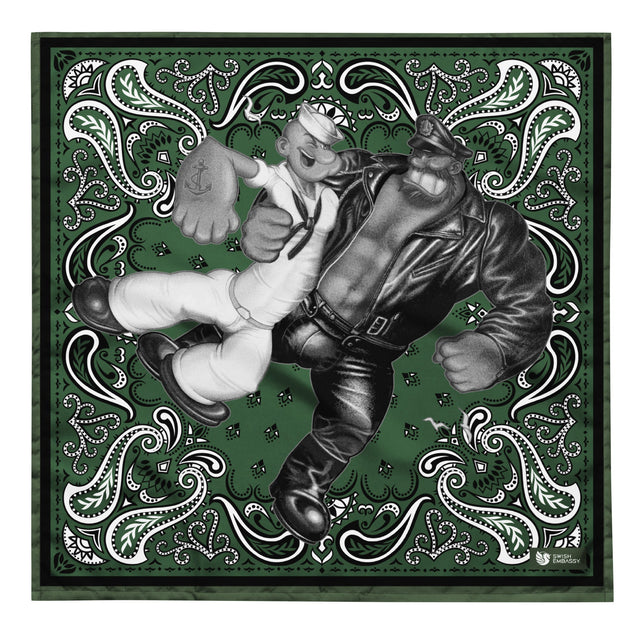Sailor of Finland (Hanky Code)
Sailor of Finland (Hanky Code) - S / Navy está agotado y se enviará tan pronto como vuelva a estar disponible.
Hecho en 2-4 días
Hecho en 2-4 días
¡Estamos totalmente enfocados en hacer que tu pedido llegue lo más rápido posible! 🌟 Cada uno de nuestros productos está hecho a medida solo para ti, bajo demanda. ¿Y adivina qué? ¡Un asombroso 95% de nuestros artículos están listos para enviar en solo 2-4 días hábiles!
Sin embargo, a veces, si un producto se hace el difícil (ya sabes, esos pequeños contratiempos de stock) o necesita un poco de cariño extra para pasar nuestras rigurosas pruebas de calidad, puede tardar un poco más en llegar a ti.
Solo un aviso: Una vez que iniciamos la producción de tu pedido, no podemos pausar ni cancelarlo. Y aunque nos encantaría, predecir fechas de entrega exactas aún no es nuestro superpoder. 📅✨
Tipos de ropa y accesorios disponibles para la compra
Tipos de ropa y accesorios disponibles para la compra
Ropa
Cuando se trata de ropa para adultos, hay una amplia gama de artículos disponibles para satisfacer diferentes gustos y necesidades. Aquí hay algunas opciones populares:
T-Shirts: Clásico y versátil, perfecto para el uso diario.
Hoodies: Ideal para el clima más fresco, ofreciendo comodidad y estilo.
Camisetas de Manga Larga: Genial para usar en capas o llevar por sí solos.
Sudaderas de cuello redondo: Una opción acogedora para atuendos informales.
Tank Tops: Perfecto para días calurosos o como una prenda de capas.
Camisetas de béisbol: Deportivos y elegantes, son ideales para un look casual.
Accesorios
Para complementar tu vestuario, considera agregar algunos accesorios elegantes:
Sombreros: De gorras de béisbol a gorros, hay algo para cada estilo. New!
Totes: Conveniente y elegante para llevar lo esencial.
Bolsos cruzados: Bolsos elegantes para llevar por la ciudad.
Artículos para el hogar
Más allá de la ropa y los accesorios, también hay varios artículos para el hogar que mejorarán tu espacio vital:
Mugs: Empieza tu día con un diseño favorito en tu taza de café.
Flags: Añade un toque especial a tu habitación con banderas bellamente diseñadas.
Arte de Pared: Perfecto para decorar tu hogar u oficina.
Pillows: Añade comodidad y estilo a tu espacio vital con cojines decorativos.
resumen, hay una amplia selección de ropa, accesorios y artículos para el hogar disponibles, ofreciendo algo para todos. Ya sea que estés buscando básicos clásicos para tu guardarropa o artículos únicos para decorar tu hogar, no hay escasez de opciones para elegir.
Información de cuidado
Información de cuidado
 |
Lavar a máquina en frío, del revés, ciclo suave con detergente suave y colores similares. |
 |
Use blanqueador sin cloro, solo cuando sea necesario. No usar suavizantes de telas. |
 |
Secar a baja temperatura, o; |
 |
Secar al aire para una mayor durabilidad. |

|
Plancha del revés si es necesario. No planchar el área impresa. |
 |
No limpiar en seco. |
Estandares Ecológicos y Laborales
Estandares Ecológicos y Laborales
Ecológico y Normas Laborales para nuestras camisetas*
- Tejidos cortados y teñidos en EE. UU.
- Libre de Talleres de Sufrimiento
- Montaje Final en América Central
- Certificado WRAP
- 7 veces menos uso de agua que otros
- Energía solar utilizada donde sea posible
- Inks compatibles con Oeko-Tex
- Impreso en países con altos estándares laborales, incluyendo: EE. UU., Canadá, México, Unión Europea, Japón, Australia.
*Se aplica a la gran mayoría de nuestros productos, incluyendo: camisetas estándar, camisetas sin mangas, camisetas de venta al por menor, camisetas para mujeres, sudaderas y mangas largas.
Políticas
Políticas
- Si encuentras algún defecto de fabricación en tu pedido de Swish Embassy, estás cubierto por 30 días después de la entrega.
- Simplemente tome fotos del problema y contacte a nuestro equipo de servicio al cliente. Ellos organizarán un proceso de devolución para un reemplazo, reembolso o crédito en la tienda.
- 🟢 Tolerancia de Tamaño: ¡Los clientes que compran por primera vez y no están seguros sobre las tallas pueden relajarse! Si su artículo no es la talla correcta, ofrecemos un cambio único de hasta 3 artículos a una talla diferente, sin cargo, o proporcionamos un crédito en la tienda por su valor. Además, no es necesario devolver el artículo original.
- 🔴 Cambio de Corazón: Debido a nuestro proceso de producción personalizado y bajo demanda, no podemos aceptar devoluciones de artículos si cambias de opinión. Este enfoque nos ayuda a reducir la sobreproducción, por lo que apreciamos tus compras reflexivas.
- 🔴 Ropa Íntima: Los artículos como ropa interior, trajes de baño y artículos de cuero no son retornables por razones de salud e higiene. Una vez comprados, son tuyos para quedarte.
Envío
Envío
En Swish Embassy, creemos en ofrecerte moda feroz con velocidad relámpago. Enviamos desde EE. UU., Canadá, México, Reino Unido, Unión Europea, Australia y Japón, ¡cariño! Para mantener las cosas ajustadas y en su punto, dirigimos tu pedido a la instalación más cercana, asegurando que tu estilo llegue más rápido que una reina desfilando por la pasarela.
Utilizamos servicios postales estándar y empresas de mensajería dependiendo de a dónde estemos enviando. Descubre tus opciones de envío y la fecha estimada de entrega al finalizar la compra.
Tabla de Tallas
Table of Contents
Camisetas
Camisetas y Triblends Camisetas sin mangas Mangas Largas Sudaderas Jerséis Camisetas Cortas Camisas de BotónPantalones
Pantalones de chándal Medias Bañadores KaftanesAccesorios
Gorras Snapback Gorras de Papá Gorras Flexfit Gorras de camionero
| Camisetas y Triblends | XS | S | M | L | XL | 2XL | 3XL | 4XL |
|---|---|---|---|---|---|---|---|---|
| Pecho (pulgadas) | 31-34 | 34-37 | 38-41 | 42-45 | 46-49 | 50-53 | 54-57 | 58-61 |
| Longitud (pulgadas) | 27 | 28 | 29 | 30 | 31 | 32 | 33 | 34 |
| Chest (cm) | 79-86 | 86-93 | 96-104 | 106-114 | 116-124 | 127-134 | 137-144 | 147-155 |
| Length (cm) | 68.5 | 71.1 | 73.6 | 76.2 | 78.7 | 81.2 | 83.8 | 86.3 |

| Tank Tops | XS | S | M | L | XL | 2XL |
|---|---|---|---|---|---|---|
| Pecho (pulgadas) | 31-34 | 34-37 | 38-41 | 42-45 | 46-49 | 50-53 |
| Longitud (pulgadas) | 26 | 27 | 28 | 29 | 30 | 31 |
| Chest (cm) | 79-86 | 86-93 | 96-104 | 106-114 | 116-124 | 127-134 |
| Length (cm) | 66 | 68.5 | 71 | 74 | 76 | 79 |

| Mangas Largas | XS | S | M | L | XL | 2XL | 3XL | 4XL |
|---|---|---|---|---|---|---|---|---|
| Pecho (pulgadas) | - | 35 | 39 | 43 | 47 | 49 | - | - |
| Longitud (pulgadas) | - | 27.6 | 28.7 | 29.2 | 30.4 | 31.4 | - | - |
| Chest (cm) | - | 88.9 | 99 | 109.2 | 119.3 | 124.4 | - | - |
| Length (cm) | - | 70.1 | 72.8 | 74.1 | 77.2 | 79.7 | - | - |

| Hoodies | S | M | L | XL | 2XL | 3XL | 4XL | 5XL |
|---|---|---|---|---|---|---|---|---|
| Tamaño del pecho (pulgadas) | 40 | 44 | 48 | 52 | 56 | 60 | 64 | 68 |
| Longitud (pulgadas) | 26 | 27 | 28 | 29 | 30 | 31 | 32 | 33 |
| Chest (cm) | 102 | 112 | 122 | 132 | 142 | 152 | 163 | 172 |
| Length (cm) | 66 | 68.5 | 71 | 72 | 76 | 79 | 81 | 83 |

| Jerseys | 2XS | XS | S | M | L | XL | 2XL | 3XL | 4XL | 5XL | 6XL |
|---|---|---|---|---|---|---|---|---|---|---|---|
| Pecho (pulgadas) | 34 ⅝" | 36 ¼" | 37 ¾" | 39 ⅜" | 42 ½" | 45 ¾" | 48 ¾" | 52" | 55 ⅛" | 58 ¼" | 61 ⅜" |
| Cintura (pulgadas) | 28 ¼" | 29 ⅞" | 31 ½" | 33 ⅛" | 36 ¼" | 39 ⅜" | 42 ½" | 45 ¾" | 48 ¾" | 52" | 55 ⅛" |
| Caderas (pulgadas) | 35 ⅜" | 37" | 38 ⅝" | 40 ¼" | 43 ¼" | 46 ½" | 49 ⅝" | 52 ¾" | 55 ⅞" | 59 ⅛" | 62 ¼" |
| Chest (cm) | 88 | 92 | 96 | 100 | 108 | 116 | 124 | 132 | 140 | 148 | 156 |
| Waist (cm) | 72 | 76 | 80 | 84 | 92 | 100 | 108 | 116 | 124 | 132 | 140 |
| Hips (cm) | 90 | 94 | 98 | 102 | 110 | 118 | 126 | 134 | 142 | 150 | 158 |

| Crop Tops | XS | S | M | L | XL |
|---|---|---|---|---|---|
| Longitud (pulgadas) | 17 ⅜" | 17 ¾" | 18 ¼" | 18 ¾" | 19 ⅛" |
| Ancho (pulgadas) | 18 ¾" | 19 ¾" | 20 ⅝" | 21 ⅝" | 22 ⅝" |
| Length (cm) | 44.1 | 45.1 | 46.4 | 47.6 | 48.6 |
| Width (cm) | 47.6 | 50.1 | 52.4 | 54.9 | 57.4 |

| Button-Up Shirts | 2XS | XS | S | M | L | XL | 2XL | 3XL | 4XL | 5XL | 6XL |
|---|---|---|---|---|---|---|---|---|---|---|---|
| Ancho (pulgadas) | 20 ½" | 21 ¼" | 22" | 22 ¾" | 24 ⅜" | 26" | 27 ⅝" | 29 ⅛" | 30 ¾" | 32 ¼" | 33 ⅞" |
| Longitud (pulgadas) | 30 ⅛" | 30 ½" | 30 ⅞" | 31 ¼" | 32 ⅛" | 32 ⅞" | 33 ¾" | 35" | 35 ¾" | 36 ⅝" | 37 ⅜" |
| Manga (pulgadas) | 10 ¼" | 10 ¼" | 10 ¼" | 10 ¼" | 10 ⅜" | 10 ⅝" | 10 ¾" | 11" | 11 ¼" | 11 ⅜" | 11 ⅝" |
| Width (cm) | 52.1 | 54 | 55.9 | 57.8 | 62 | 66 | 70.2 | 74 | 78.1 | 81.9 | 86.1 |
| Length (cm) | 76.5 | 77.5 | 78.4 | 79.4 | 81.6 | 83.6 | 85.7 | 89 | 90.8 | 93 | 95 |
| Sleeve (cm) | 26 | 26 | 26 | 26 | 26.4 | 27 | 27.3 | 28 | 28.6 | 28.9 | 29.5 |

| Snapback Hats | Talla Única |
|---|---|
| Circunferencia (pulgadas) | 20 ⅛" - 23 ⅝" |
| Altura (pulgadas) | 4 ½" |
| Profundidad del ala (pulgadas) | 2 ½" |
| Ancho de ala (pulgadas) | 7 ⅛" |
| Circunferencia (cm) | 51 - 60 cm |
| Height (cm) | 11.4 cm |
| Profundidad del ala (cm) | 6.4 cm |
| Ancho de ala (cm) | 18.1 cm |

| Dad Hats | Una Talla |
|---|---|
| Circunferencia (pulgadas) | 20 ½" - 24 ⅜" |
| Altura (pulgadas) | 4 ¾" |
| Profundidad del ala (pulgadas) | 3 ⅛" |
| Ancho de ala (pulgadas) | 7 ½" |
| Circunferencia (cm) | 52 - 62 cm |
| Height (cm) | 12 cm |
| Profundidad del ala (cm) | 8 cm |
| Ancho de ala (cm) | 19 cm |

| Flexfit Hats | S/M | L/XL |
|---|---|---|
| Circunferencia (pulgadas) | 21 ¼" - 22 ¾" | 22 ⅜" - 23 ⅞" |
| Altura (pulgadas) | 4 ½" | 4 ⅞" |
| Profundidad de ala (pulgadas) | 2 ½" | 2 ½" |
| Ancho de ala (pulgadas) | 6 ⅝" | 6 ⅝" |
| Circunferencia (cm) | 54 - 58 cm | 57 - 61 cm |
| Height (cm) | 11.4 cm | 12.4 cm |
| Profundidad del ala (cm) | 6.4 cm | 6.4 cm |
| Ancho de ala (cm) | 16.8 cm | 16.8 cm |

| Trucker Hats | Una Talla |
|---|---|
| Circunferencia (pulgadas) | 21 ⅝" - 23 ⅝" |
| Altura (pulgadas) | 3 ⅞" |
| Profundidad de ala (pulgadas) | 2 ½" |
| Ancho de ala (pulgadas) | 6 ¾" |
| Circunferencia (cm) | 55 - 60 cm |
| Height (cm) | 9.8 cm |
| Profundidad del ala (cm) | 6.4 cm |
| Ancho de ala (cm) | 17.1 cm |

| Sweat Pants | XS | S | M | L | XL | 2XL |
|---|---|---|---|---|---|---|
| Longitud de la entrepierna (pulgadas) | 28" | 29" | 30" | 31" | 32" | 33" |
| Cintura (pulgadas) | 28" | 30" | 32" | 34" | 36" | 38" |
| Longitud de la entrepierna (cm) | 71.1 cm | 73.7 cm | 76.2 cm | 78.7 cm | 81.3 cm | 83.8 cm |
| Cintura (cm) | 71.1 cm | 76.2 cm | 81.3 cm | 86.4 cm | 91.4 cm | 96.5 cm |

| Tights | XS | S | M | L | XL | 2XL | 3XL |
|---|---|---|---|---|---|---|---|
| Cintura (pulgadas) | 26" | 27 ½" | 29 ¼" | 32 ¼" | 35 ½" | 38 ½" | 41 ¾" |
| Entrepierna (pulgadas) | 29 ½" | 29 ⅞" | 30 ¼" | 30 ¾" | 31 ⅛" | 31 ½" | 31 ⅞" |
| Aumento Frontal (pulgadas) | 10 ⅜" | 10 ⅝" | 10 ⅞" | 11" | 11 ¼" | 11 ⅜" | 11 ⅝" |
| Waist (cm) | 66 cm | 70 cm | 74 cm | 82 cm | 90 cm | 98 cm | 106 cm |
| Inseam (cm) | 75 cm | 76 cm | 77 cm | 78 cm | 79 cm | 80 cm | 81 cm |
| Aumento Frontal (cm) | 26.4 cm | 27 cm | 27.6 cm | 28 cm | 28.6 cm | 28.9 cm | 29.5 cm |

| Swim Trunks | 2XS | XS | S | M | L | XL | 2XL | 3XL | 4XL | 5XL | 6XL |
|---|---|---|---|---|---|---|---|---|---|---|---|
| Cintura (pulgadas) | 23 ½" | 25 ¼" | 26 ¾" | 28 ¼" | 31 ½" | 34 ¾" | 37 ¾" | 41" | 44" | 47 ¼" | 50 ½" |
| Aumento Frontal (pulgadas) | 11 ¾" | 12" | 12 ¼" | 12 ⅜" | 12 ¾" | 13 ⅜" | 13 ¾" | 14 ⅜" | 14 ¾" | 15 ⅜" | 15 ¾" |
| Longitud (pulgadas) | 16 ⅞" | 17 ⅛" | 17 ⅜" | 17 ½" | 18 ⅛" | 18 ¾" | 19 ¼" | 20 ⅛" | 20 ½" | 21 ¼" | 21 ⅝" |
| Entrepierna (pulgadas) | 6 ½" | 6 ½" | 6 ½" | 6 ½" | 6 ½" | 6 ⅞" | 6 ⅞" | 7 ⅛" | 7 ⅛" | 7 ¼" | 7 ¼" |
| Waist (cm) | 60 cm | 64 cm | 68 cm | 72 cm | 80 cm | 88 cm | 96 cm | 104 cm | 112 cm | 120 cm | 128 cm |
| Aumento Frontal (cm) | 30 cm | 30.5 cm | 31 cm | 31.5 cm | 32.5 cm | 34 cm | 35 cm | 36.5 cm | 37.5 cm | 39 cm | 40 cm |
| Length (cm) | 43 cm | 43.5 cm | 44 cm | 44.5 cm | 46 cm | 47.5 cm | 49 cm | 51 cm | 52 cm | 54 cm | 55 cm |
| Inseam (cm) | 16.5 cm | 16.5 cm | 16.5 cm | 16.5 cm | 16.5 cm | 17.5 cm | 17.5 cm | 18 cm | 18 cm | 18.5 cm | 18.5 cm |

| Kaftans | 2XS | XS | S | M | L | XL | 2XL | 3XL | 4XL | 5XL | 6XL |
|---|---|---|---|---|---|---|---|---|---|---|---|
| Pecho (pulgadas) | 37 ¾" | 39 ½" | 41" | 42 ½" | 45 ¾" | 48 ¾" | 52" | 55" | 58 ¼" | 61 ½" | 64 ½" |
| Longitud (pulgadas) | 34 ¼" | 34 ⅝" | 35" | 35 ⅜" | 36 ¼" | 37" | 37 ¾" | 38 ⅝" | 39 ⅜" | 40 ⅛" | 41" |
| Manga (pulgadas) | 8 ⅛" | 8 ¼" | 8 ½" | 8 ⅝" | 8 ⅞" | 9" | 9 ¼" | 9 ½" | 9 ⅝" | 9 ⅞" | 10" |
| Chest (cm) | 95.9 cm | 100.3 cm | 104.1 cm | 108 cm | 116.2 cm | 123.8 cm | 132.1 cm | 139.7 cm | 148 cm | 156.2 cm | 163.8 cm |
| Length (cm) | 87 cm | 88 cm | 89 cm | 90 cm | 92 cm | 94 cm | 95.9 cm | 98 cm | 100 cm | 102 cm | 104 cm |
| Sleeve (cm) | 20.6 cm | 21 cm | 21.6 cm | 21.9 cm | 22.5 cm | 23 cm | 23.5 cm | 24.1 cm | 24.4 cm | 25 cm | 25.4 cm |
Descripción
Descripción
Our custom handkerchiefs merge the heritage of the Hanky Code with modern aesthetics. These hankies are not just a mode of communication within the gay community but also a statement piece.
Colors and Meanings:
- Navy: Anal sex (worn on left: top, worn on right: bottom)
- Hunter Green: Daddy/boy dynamic (worn on left: daddy, worn on right: boy)
- Yellow: Watersports (worn on left: ws top, worn on right: ws bottom)
- Red: Fisting (worn on left: ff top, worn on right: ff bottom)
Ideal for Gifts and Collectors: These hankies are a thoughtful gift for those who value LGBTQ+ history. They are also a unique addition for collectors seeking to combine tradition with contemporary style.
Embrace Your True Colors: With our "custom Hanky Codes, you get to express your identity and desires, in one stylish accessory.
Product Specs:
- Material Composition: Crafted with 65% recycled polyester and 35% polyester, blending eco-friendliness with durability.
- Fabric Weight: Light yet robust with a fabric weight of 2.95 oz/yd² (100 g/m²), ensuring a comfortable, all-day wear.
- Comfort and Feel: Breathable and moisture-wicking material keeps you comfortable in various settings, while the fabric's softness is gentle on the skin.
- Quality Finish: Double-folded edges provide a neat, durable finish, ensuring longevity and resilience.
- Design: Each hanky features a single-sided print with original designs that subtly complement the color's traditional meaning.
- Versatility: Multifunctional in nature, these hankies can be used for traditional signaling, as a fashion accessory, or even as a practical cloth in everyday situations.
- Sun Protection: Equipped with UPF50+ protection, offering an extra layer of defense against harmful UV rays.
- Certifications: Our fabric is certified by OEKO-TEX 100 standard and the Global Recycled Standard (GRS), ensuring safety and sustainability in production.
- Ethical Sourcing: Blank product components are responsibly sourced from China, adhering to high standards of quality and ethical practices.
Size guide
| LENGTH (inches) | WIDTH (inches) | |
| S | 17 ⅜ | 17 ⅜ |
| M | 21 ¼ | 21 ¼ |
| L | 25 ¼ | 25 ¼ |
The Role of the Hanky Code in Promoting Equality and Self-Expression in the Gay Community
The Hanky Code is more than just a symbol; it's a testament to the resilience and creativity of the gay community. Originating as a discreet way for gay men to communicate their interests and desires, this coded system of colored bandanas served a critical function during times when open expression could invite danger.
A Historical Necessity
At its inception, the Hanky Code was an ingenious solution to a dire problem. Being openly gay was socially unacceptable and often perilous. The coded hankies provided a way to identify and connect with like-minded individuals safely. This covert communication underscored the community's ability to adapt and thrive, even under oppressive circumstances.
Emblem of Resilience
Far from being a relic of the past, the Hanky Code is a powerful symbol of the ongoing fight for equality. It represents the community's undaunted spirit and the unyielding quest for self-expression. Even today, as society becomes more accepting, the Hanky Code reminds us of the struggles endured and the triumphs achieved.
Celebrating Natural Identity
By embracing the Hanky Code, the gay community reaffirms that being homosexual is a natural aspect of humanity. It's a statement of pride, a rejection of shame, and a demonstration of solidarity. Each colored hanky worn today honors the history of those who fought for the right to love openly and proudly.
The Continuing Battle for Equality
As the 50th anniversary of the gay civil rights movement approaches, the Hanky Code continues to be relevant. It serves as a reminder that the battle for full equality and acceptance is ongoing. While society has made significant strides, there are still many hurdles to overcome. The Hanky Code's legacy inspires both remembrance and action, urging newer generations to continue pushing boundaries and breaking down barriers.
In Summary
The Hanky Code's contribution to the fight for equality and self-expression cannot be overstated. It is a bold reminder of the community's struggle and a beacon of hope for a more inclusive future. By wearing a hanky, one doesn't just communicate personal interests but also participates in a broader dialogue about identity, resilience, and the enduring fight for equality.
Why is it Important to Remember and Honor the History of the Hanky Code?
The history of the Hanky Code is a poignant reminder of the ingenuity and resilience that characterized the LGBTQ+ community during times of persecution. Understanding and honoring this part of gay history serves several crucial purposes.
A Symbol of Tenacity
The Hanky Code emerged as a covert method for LGBTQ+ individuals to communicate and express their identities in a hostile world. By utilizing various colored handkerchiefs to signal specific interests and preferences, community members found innovative ways to connect and support each other. This ingenuity is a testament to the tenacity of the gay community in navigating oppressive circumstances.
A Legacy of Communication
Before the digital age, signaling and communicating in code was a vital strategy for safety and solidarity within the gay community. The Hanky Code exemplifies how marginalized groups develop intricate systems to foster a sense of belonging and ensure mutual understanding.
Celebrating Natural Diversity
Recognizing the history of the Hanky Code reinforces the message that being homosexual is a natural and valid phenomenon. This acknowledgment helps to dismantle shame and stigma, encouraging a culture of acceptance and pride.
Honoring the Struggle
As we approach milestones like the 50th anniversary of the gay civil rights movement, reflecting on the Hanky Code reminds us of the ongoing struggle for equality. The fight is far from over, and revisiting these historical symbols galvanizes current and future efforts.
Key Takeaways
- Emphasizes the community's adaptability and resourcefulness.
- Highlights the importance of coded communication in queer history.
- Validates and celebrates natural sexual diversity.
- Inspires continual activism for equal rights.
By remembering and honoring the history of the Hanky Code, we not only pay homage to the past but also draw strength and inspiration for the future.
The Modern Use of the Hanky Code in Gay Communities
A Symbolic Tradition
In today’s LGBTQ+ communities, the Hanky Code has evolved yet remains a celebrated tradition. Originally a discreet way to communicate sexual preferences and interests, this coded system of colored handkerchiefs now finds new life as both a fashion statement and a nod to historical culture.
Fashion and Fetish Gear
It's common to see various types of fetish gear, such as leather harnesses and armbands, adorned with colors inspired by the Hanky Code. These accessories are not just for show; they convey specific messages about the wearer’s interests. So if someone’s following you after you don your yellow-trimmed harness, the code might just be working as intended.
Open Discussions
Today's society allows for more open discussions regarding personal preferences and identities. While not everyone might choose to signal their interests through colored handkerchiefs, understanding and respecting those who do is vital. These colors provide a language that fosters connection and understanding within LGBTQ+ communities.
A Personal Choice
Flagging through the Hanky Code is a deeply personal decision. For many, especially within the leather community, these flags go beyond mere fabric. They serve as badges of honor—symbols of achievements, shared intimacies, and personal milestones on the journey toward self-discovery and fulfillment.
Pride and Brotherhood
Colored handkerchiefs are often publicly displayed with pride. They aren’t just about signaling sexual preferences or interests; they represent a brotherhood, a shared language of respect, and recognition of one’s journey within the community. These simple flags hold deep significance, offering validation and celebrating personal growth.
By acknowledging and understanding the Hanky Code, modern gay men and their communities continue to bridge the past with the present, honoring both the tradition and evolution of their shared identities.
The Hanky Code: A Testament to the Resilience and History of the Gay Community
The Hanky Code stands as a poignant symbol within gay history, reflecting both resilience and the challenges faced by the community. Originating during a time when open communication about one's sexual orientation was often dangerous, this coded system allowed individuals to express their identities discreetly yet profoundly.
Signaling Strength in Silence
In an era when being openly gay could lead to severe consequences, the Hanky Code offered a means of silent communication. It demonstrated the community's creativity and determination to connect despite societal barriers. Each color and placement of a handkerchief conveyed specific desires or characteristics, creating a clandestine yet vibrant method of interaction.
Overcoming Adversity
The necessity of such codes underscores the adversity faced by the gay community. Despite these challenges, the development and use of the Hanky Code illustrate an unwavering spirit and a refusal to be silenced. It became a tool not only for personal expression but also for communal solidarity and support.
Embracing Identity
One of the most powerful aspects of the Hanky Code is how it embraced and celebrated identity. Rather than succumbing to societal pressure to hide, individuals used the code to assert their natural orientation with pride. This practice helped lay the groundwork for a broader movement recognizing the dignity and humanity of gay individuals.
Historical Significance
As we approach significant milestones in the gay civil rights movement, reflecting on the Hanky Code is especially pertinent. It serves as a reminder of the creative and resilient methods the community has employed to navigate and overcome systemic oppression.
By celebrating the ingenuity behind the Hanky Code, we honor not just a historical artifact, but a powerful testament to the enduring resilience of the gay community.
Understanding the Deeper Meanings of the Hanky Code
The Hanky Code, often viewed as an outdated relic, actually carries profound significance for many individuals in the LGBTQ+ community today. Especially among Leathermen, these colored flags are far more than mere accessories; they symbolize deeply personal milestones and connections.
For many, the flags are worn with pride, serving as a badge of honor. They represent significant accomplishments, whether it's mastering a new skill, overcoming a personal challenge, or reaching a long-sought goal. Each color and pattern can signify different achievements or qualities, embodying a message of personal fulfillment and validation.
Key Messages Conveyed by the Hanky Code:
-
Personal Achievements:
- Flags can denote individual successes and milestones.
- They symbolize hard-earned accomplishments and personal growth.
-
Intimate Connections:
- Colored flags often represent shared experiences and deep connections within the community.
- They acknowledge boundaries explored and intimate relationships formed.
-
Brotherhood and Community:
- Wearing a flag can signify one's place within a supportive and understanding brotherhood.
- It showcases participation in a collective journey towards self-discovery.
-
Self-Expression and Identity:
- The flags allow individuals to express their unique identities and preferences.
- They stand as a testament to one's journey in self-fulfillment and higher self.
Ultimately, the Hanky Code serves as a powerful tool for self-expression, deepening personal connections, and marking significant life achievements. It is a noble quest for self-fulfillment, and each flag worn is a chapter in that ongoing journey.
Why is the Hanky Code Considered an Important Part of Gay History?
The Hanky Code stands as a significant milestone in gay history, symbolizing both resilience and ingenuity. Developed as a covert communication system, it enabled gay men to discreetly express their desires and preferences during times when openly discussing such topics was fraught with danger.
Key Reasons the Hanky Code is Important:
-
Historical Symbol of Resilience:
- During periods of intense social stigma and legal persecution, the Hanky Code provided a vital means for individuals to safely interact and find like-minded companions. This resilience highlights the community's courage in the face of adversity.
-
Coded Communication:
- In an era when being openly gay could lead to severe consequences, the Hanky Code allowed for a level of privacy and security. This method of coded communication reflects the innovative ways the gay community adapted to oppressive circumstances.
-
Cultural Identity and Unity:
- Beyond its practical applications, the Hanky Code fostered a sense of identity and unity within the gay community. It became a shared language and cultural touchstone, reinforcing bonds and promoting solidarity.
-
Natural Human Expression:
- The existence and use of the Hanky Code underscore the natural human need for connection and self-expression. It serves as a poignant reminder that being homosexual is a natural phenomenon, deserving of acceptance and respect.
-
Historical Recognition:
- As we approach significant anniversaries in the fight for gay civil rights, the Hanky Code is an enduring testament to the progress and ongoing efforts toward equality. It reminds us of the struggles overcome and the resilience demonstrated by those who came before us.
In essence, the Hanky Code is more than just a relic of the past. It’s a powerful symbol of the gay community’s enduring spirit and an important piece of cultural heritage. This code is a testament to the innovative, resilient, and determined nature of a community that continues to strive for acceptance and equality.
Understanding the Hanky Code: Limitations and Purposes
The Hanky Code serves as a unique mode of communication within particular communities, primarily used to signal sexual preferences. However, like any system, it has its boundaries and specific intents.
Limitations
One significant limitation of the Hanky Code is its ephemeral nature. Human desires and moods are always in flux, and what someone signals today might not be what they are interested in tomorrow. Because of this variability, relying solely on hankies doesn't offer a comprehensive analysis of someone’s sexual propensities.
Additionally, the code isn't designed for intricate psychoanalysis. It's a superficial indicator rather than a deep-dive into someone's erotic psyche. Thus, there's a risk of misinterpretation if one takes the hankies at face value without further discussion.
Intended Purposes
Despite these limitations, the Hanky Code's primary purpose is to serve as a conversation starter. By wearing specific hankies, individuals can convey basic information about their sexual interests at a glance, paving the way for further dialogue. It's meant to initiate connections and facilitate initial interactions rather than serve as a conclusive guide.
The temporarily descriptive nature of these flags makes them ideal for quickly assessing compatibility. For instance:
- Wearing a red hanky could signal an interest in a particular kink.
- Donning a blue hanky might indicate another specific preference.
However, these flags are not meant to box individuals into rigid categories. Rather, they offer a spectrum of possibilities within each color, allowing for exploration and negotiation. This encourages an open-minded approach where everything remains subject to discussion and mutual agreement.
In essence, the Hanky Code is an ice-breaker, a tool to ease into deeper conversations about personal preferences without being a definitive roadmap. It's a gateway to understanding and exploring the vast terrain of human sexuality.
Historical Origins of Using Colored Bandanas as Coded Language
The practice of using colored bandanas as a form of coded language dates back to the mid-1800s during the Gold Rush era. This period saw a unique social dynamic among miners, often referred to colloquially as "hillbillies."
During social events like the Miner’s Ball, there was a notable gender imbalance, with far fewer women than men. To ensure that everyone had an opportunity to participate in the dances, some men took it upon themselves to dance the roles traditionally reserved for women.
A practical system was devised to indicate who was dancing which part:
- Red Bandanas: Worn by those taking on the 'male' or lead role.
- Blue Bandanas: Worn by those assuming the 'female' or follow role.
The Significance
This method served two primary purposes:
- Clarity in Dance Roles: The bandanas visually communicated who would lead and who would follow, simplifying the dance process.
- Inclusivity: It allowed for greater participation by accommodating the gender imbalance, ensuring no miner missed out on the fun.
Broader Impact
This innovative system of non-verbal communication caught on and paved the way for using colored accessories to signify various roles or preferences in different social contexts.
The legacy of these Gold Rush-era miners and their practical use of bandanas contributed to the broader use of coded signals that persists in various forms of social signaling even today.
The Evolution of the Hanky Code: Embracing New Fetishes and Preferences
Expansion Beyond Tradition
The Hanky Code, a notable piece of LGBTQ+ history, has continually evolved to embrace new expressions of identity and desire. Originating in the 1970s as a discreet way for gay men to signal their sexual interests in public, the code has expanded significantly as the internet and community growth have influenced its scope.
Modern Additions and Innovations
The code's flexibility has allowed for the inclusion of various colors and fabrics to represent an ever-growing array of fetishes and preferences. For example:
- Aluminum Foil: Signifying interest in electrical stimulation.
- Chain Collar: Representing the slave role play fetish.
- Handy Wipe: Indicating a motor oil fetish.
- Doily: Suggesting a preference for public restroom scenes.
Dynamic Adaptation
As new fetishes are discovered and societal norms shift, the Hanky Code adapts to meet the community's needs. This evolution highlights the importance of inclusivity and the diverse nature of human sexuality. Each addition provides a subtle yet clear way for individuals to communicate their interests, ensuring everyone has a place within this cultural phenomenon.
This modern adaptation of the Hanky Code reflects the continual growth and increasing diversity of the LGBTQ+ community, underscoring its enduring relevance and ability to accommodate new fetishes and preferences seamlessly.
The Role of Leather and Fetish Communities in Creating the Hanky Code
The leather and fetish communities in gay San Francisco played a pivotal role in the creation of the Hanky Code. Originating in these subversive underground networks, the code provided a discreet way for men to express their specific sexual interests and kinks without uttering a word. This innovative system of flagging allowed members to reveal their desires and boundaries through a simple yet effective language of colored handkerchiefs.
By adopting and transforming an outdated signaling method, these communities created a new form of communication that was both practical and inclusive. It wasn’t just about secrecy; it was about forging connections and fostering a sense of belonging among like-minded individuals. The Hanky Code soon became a quintessential part of the gay subculture, reflecting the creativity and resilience of those who felt marginalized.
Key Points:
- Origin: Developed within the underground leather and fetish scenes.
- Purpose: To communicate sexual interests discreetly.
- Innovation: Revamped an old concept for contemporary use.
- Impact: Enabled safe, non-verbal communication among community members.
This system not only highlighted the ingenuity of the community but also reinforced a shared identity through a nuanced, coded language.
The Rise of the Hanky Code: From Obscurity to Widespread Popularity
The Hanky Code's journey to widespread awareness and popularity began with its roots in subtle signaling among gay men. Initially, it involved a discrete practice where individuals would use keys to signify their role preferences, hanging them on the left or right side of their belt.
However, the concept truly gained momentum when it caught the eye of the media. A pivotal moment occurred when a writer from the Village Voice suggested an alternative: using handkerchiefs instead of keys to indicate one's preferences. This suggestion wasn't just a playful remark; it transformed into a revolutionary idea that rapidly spread through gay communities across the nation.
As this new trend emerged, it provided a more colorful and versatile way for gay men to communicate their desires and roles. The simplicity and effectiveness of the handkerchief system, combined with its public endorsement by influential media, allowed it to resonate deeply within the community. Not only did it offer a clearer form of communication, but it also fostered a sense of solidarity and identity among its users.
In summary, the Hanky Code's rise from an obscure practice to a widely recognized form of communication was driven by the ingenuity of substituting keys with handkerchiefs, bolstered by media exposure that helped it gain traction and popularity in gay communities nationwide.
How People with Specific Fetishes Found Like-Minded Individuals Before the Internet
Before the internet revolutionized how we connect, people with specific fetishes had to rely on creative, often subtle, methods to find like-minded individuals.
One prevailing method was the use of coded signals. Particularly popular within the leather and fetish communities in cities like San Francisco, these signals often involved discreet accessories or clothing items. For instance, different colors of handkerchiefs placed in certain pockets could indicate specific interests, desires, or boundaries. This "hanky code" allowed individuals to communicate their preferences without uttering a word.
Here's how it typically worked:
- Handkerchief Colors: Each color represented a different fetish or interest.
- Placement: The side of the body it was worn on would indicate whether one was a top/dominant (left side) or bottom/submissive (right side).
Community gatherings were another vital aspect. Bars, clubs, and private parties served as hubs where people could meet face-to-face. These venues created safe spaces where individuals could share their interests openly. For example, leather bars became iconic for fostering community bonds and easing the journey of self-discovery.
Finally, printed media played a crucial role. Underground magazines and newsletters offered not only articles and stories but also personal ads where people could discreetly describe their interests and seek out potential companions.
By leveraging these creative, yet effective methods, individuals with unique fetishes were able to build communities and find connection long before our digital age.
Controversy Surrounding Bruce Springsteen’s Album Cover and the Hanky Code
At the peak of its influence, the hanky code was an unspoken language within the LGBTQ+ community. It identified sexual preferences based on the color and placement of bandanas. This subculture detail intersected unexpectedly with mainstream media when Bruce Springsteen's BORN IN THE USA album cover featured him with a red handkerchief in his right back pocket.
What the Hanky Code Signified
In the hanky code, a red hanky in the right pocket traditionally signaled a preference for a specific type of intimate encounter that was decidedly not mainstream. Seeing this iconography on such a prominent album cover inadvertently caught the attention of those familiar with the hanky code, leading to speculation about Springsteen's personal life and preferences.
Public Perception and Response
This speculation had potential ramifications. For an artist whose image was heavily associated with American patriotism and blue-collar ethos, the inclusion of a symbol interpreted by some as a sexual signal was controversial. This led to the image being altered in subsequent releases. The red handkerchief was replaced with a red baseball cap—a symbol more aligned with the all-American, working-class hero narrative that Springsteen embodied.
PR Implications
From a public relations standpoint, this change was crucial. It mitigated any potential controversy that might alienate Springsteen's core audience, maintaining the focus on his music and iconic status rather than personal implications suggested by the hanky code.
Thus, the evolution of the album cover highlights how subtle visual elements can carry significant cultural weight and impact public perception.
Understanding the Development and Discovery of Fetishes
Fetishes can be a fascinating reflection of human sexuality. The intrigue often doesn't lie in the specific fetish itself, but rather in the journey individuals undergo to unearth these unique preferences.
The Psychological Roots
Early Experiences: Psychologists suggest that fetishes can stem from early life experiences. For instance, a seemingly innocuous event, such as witnessing or experiencing a random act of physical sensation, might embed itself in a person's psyche.
Classical Conditioning: Just like Pavlov’s dogs were conditioned to salivate at the sound of a bell, individuals might associate an object or action with sexual arousal. For example, a person who feels a particular fabric during a sexually stimulating experience may develop a fetish for that material.
The Path to Self-Discovery
Self-Exploration: Many people embark on a deep dive into their sexuality through experimentation and self-reflection. This journey may involve exploring various erotic materials, fantasies, and even engaging in different sexual practices.
Sensory Feedback: During this exploratory phase, people pay close attention to their physical and emotional responses. An unexpectedly intense reaction to a specific stimulus can be a significant clue.
Cultural and Social Influences: Exposure to diverse cultural norms and peer influences can also play a role. The availability of information on the internet further broadens the spectrum of what individuals learn and consequently, what they might be curious to experience themselves.
Unveiling the Moment
Often, individuals have an "A-ha" moment—a sudden realization triggered by an intense physical or emotional response to a particular stimulus. This revelation could be spurred by an accidental experience, such as a brush with a new texture, or through deliberate experimentation.
Building Communities
Once someone identifies their unique fetish, the next step is often seeking others who share that inclination. Online forums, social media groups, and specialized communities provide platforms for people to connect, share experiences, and gain validation.
Conclusion
The development of fetishes is an intricate interplay of psychological conditioning, personal experiences, and societal influences. Discovery often involves a combination of accidental encounters and deliberate exploration, leading to profound self-awareness and acceptance. For those interested in understanding or exploring their own fetishes, resources and communities are more accessible than ever before.
What is Tamakeri and What Questions Arise About Its Discovery and Practice?
Tamakeri is a unique fetish originating from Japan that translates directly to "ball kicking." As the name implies, it involves the erotic enjoyment of being kicked in the testicles. This particular proclivity is a subset of broader paraphilias, which are characterized by unconventional sexual desires, often involving extreme or risky activities.
Discovering the Desire for Tamakeri
One of the most intriguing aspects of tamakeri is understanding how individuals come to recognize their preference for such a specific and intense form of stimulation. The discovery process raises several compelling questions:
-
Initial Realization: How does someone first realize that they derive sexual pleasure from testicular impact?
- Was there a notable incident that triggered this understanding? Perhaps a seemingly accidental kick during a sports activity or an unexpected jolt?
-
The A-ha Moment: What was the pivotal moment of clarity?
- Did it happen during a roughhousing session in childhood or maybe during routine activities that led to an unintentional discovery?
Social and Psychological Dynamics
Once an individual acknowledges this desire, another layer of curiosity unfolds about the psychological and social dynamics involved. These include:
-
Cognitive Processing: How does one process and accept such a niche form of pleasure?
- Are there feelings of confusion or acceptance during the initial stages?
-
Finding Like-Minded Individuals: In a world where this fetish is quite rare, how do enthusiasts find others who share the same interest in tamakeri?
- Online forums, niche communities, and specialized adult entertainment might serve as initial touchpoints.
-
Community Support: Is there a supportive community where individuals can share experiences, set boundaries, and learn safe practices?
- Many participants likely seek out spaces where they can openly discuss their interests and ensure both consent and safety.
Practical Considerations
For those engaged in tamakeri, practicality and safety are paramount:
-
Setting Boundaries: Clear communication is essential to establish limits and ensure mutual consent.
-
Safety Measures: Are there standardized guidelines within the community to minimize physical harm while still achieving the desired sensations?
-
Educational Resources: What resources or materials are available for individuals new to this fetish to learn about safe practices?
- Books, expert blogs, and videos might provide crucial insights and recommendations.
By delving into these aspects, we gain a multifaceted understanding of tamakeri, from its discovery to its practice, highlighting the nuanced interplay of personal recognition, safety, and community support.
Pago y Seguridad
Métodos de pago
Su información de pago se procesa de forma segura. No almacenamos los detalles de la tarjeta de crédito ni tenemos acceso a su información de tarjeta de crédito.
